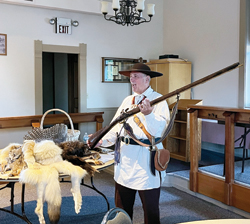Reenactment of Great Hinckley Hunt entertains locals
By Martin McConnell
The Great Hinckley Hunt of 1818 came back to life at Richfield Fellowship Hall on the evening of Aug. 11. Although most of the names of the men who took part in the hunt have been lost to time, local historian John Burke is keeping the story of the Great Hinckley Hunt alive and well.
Burke has been doing historical reenactments and lectures for the better part of the past 50 years, and has over 13 characters that he plays for various occasions. This particular character was a pioneer from the Valley City area of Ohio named Dan Mallet, for whom Mallet Creek is named.
Acting as Mallet, Burke explained that the Great Hinckley Hunt truly lived up to its title of “great.” In an attempt to keep animals from eating the local farmers’ crops and killing their livestock, 454 men joined the hunt on Christmas Eve 1818, making it the largest hunt ever recorded east of the Mississippi River.
Across three counties in northern Ohio, they were able to take down 300 deer, 21 bears, and 17 wolves, all of which the hunters skinned and harvested for meat. Wolf hides were especially valuable in 1818, and each one would net a trader $15, about $350 in modern money. Mallet went on to detail the troubles even the most efficient hunters had with flintlock weapons.
“That’s the problem with flintlocks, is that if that powder gets a little damp, you don’t even get that spark,” Mallet said, showcasing his weapon to the crowd. “That’s how we get the terminology, ‘just a flash in the pan.’”
Anything the hunters could not carry with them, they simply left to freeze in the cold Ohio wilderness of 1818. The leftover carcasses stayed frozen to the ground until March 1819.
According to local legend, in spring of 1819, a large group of buzzards spotted the carcasses beginning to thaw out, and as the saying goes, the rest is history. The infamous Hinckley buzzards still return every year on March 15, hoping to find the legendary feast they enjoyed in the early spring of 1819.
One audience member also noted after the reenactment that some of the Hinckley buzzards have been tagged by scientists. During the winter, some of them travel as far as Iquitos, Peru, another town with a rich history of buzzard and vulture sightings.
Burke aims to keep the story and tradition of the Great Hinckly Hunt alive, one reenactment at a time.
“When you see all these buzzards coming around Hinckley, now you know why,” Mallet said. “If it’s a fairly warm winter and they can still get roadkill and things like that, they may stay up here.” ∞
Photo: Medina County Treasurer John Burke reenacts the Great Hinckley Hunt of 1818. Photo by M. McConnell.

